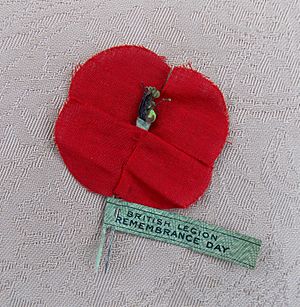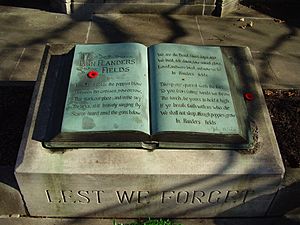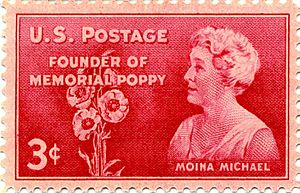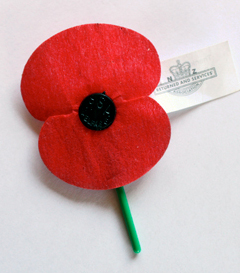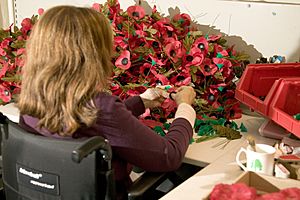Remembrance poppy facts for kids
The remembrance poppy is a special artificial flower worn in some countries. People wear it to remember soldiers who died in wars. Groups that help soldiers and their families sell these poppies. The money collected helps veterans (people who served in the military) and their families with money, support, and care.
The idea for the poppy came from a famous poem called "In Flanders Fields". This poem was written during World War I. A woman named Moina Michael helped make the poppy a symbol of remembrance. Later, Madame Guérin from France started "Poppy Days" to raise money for veterans, widows, and children affected by the war.
Today, the remembrance poppy is mostly worn in the United Kingdom and countries of the Commonwealth of Nations. These countries include Canada, Australia, and New Zealand. Veterans' groups in these places have special rights to the poppy symbol for their fundraising. People often wear small poppies on their clothes before Remembrance Day. This day is also known as Armistice Day. Poppy wreaths are also placed at war memorials. In Australia and New Zealand, poppies are also worn on ANZAC Day.
Sometimes, there are different ideas about wearing the poppy. Some people, including veterans, feel the poppy is used too much. They think it might be used to support military actions. They also feel that public figures are sometimes pressured to wear poppies.
Why We Wear Poppies
The idea for the poppy comes from a poem written during World War I. The poem is called "In Flanders Fields". It talks about red poppies growing in the battlefields of Belgium. These poppies grew among the graves of soldiers who had died. The poem was written by a Canadian doctor, John McCrae. He wrote it on May 3, 1915, after his friend died in battle. The poem was first printed in a magazine called Punch in December 1915.
Moina Michael was a teacher who volunteered during the war. She was inspired by McCrae's poem. In 1918, she wrote her own poem called "We Shall Keep the Faith". She promised to always wear a red poppy to remember those who fought in the war. In November 1918, she wore a silk poppy to a meeting. She also gave poppies to others. She then worked hard to make the poppy a national symbol of remembrance.
In 1920, a group called the National American Legion chose the poppy as their official symbol. A French woman named Madame Guérin spoke to them. She talked about an 'Inter-Allied Poppy Day'. After this, the American Legion also adopted the poppy. They supported Madame Guérin's plan for a U.S. Poppy Day. They even called her "The Poppy Lady from France." Madame Guérin organized the first nationwide Poppy Day in the U.S. in May 1921. The silk poppies used were made by widows and children in war-torn areas of France.
Later, the American Legion stopped using the poppy. But another group, the Veterans of Foreign Wars (V.F.W.), continued to support Madame Guérin. They bought French-made poppies from her. The V.F.W. held the first veterans' Poppy Day Drive in the U.S. in 1922. In 1924, the V.F.W. officially registered the "Buddy Poppy" name.
Madame Guérin's idea for 'Inter-Allied Poppy Day' also spread to parts of the British Empire. After her visit to the U.S., she went to Canada. The Great War Veteran Association in Canada adopted the poppy emblem in July 1921. They were the first British Empire veterans to do so.
Madame Guérin also sent a representative to Australia and New Zealand. Then she traveled to Great Britain. She told Field Marshal Douglas Haig and The Royal British Legion about her idea. The British Legion did not have much money. So, Madame Guérin paid for the first British remembrance poppies herself. The British Legion paid her back after their first Poppy Day on November 11, 1921.
Historian James Fox points out that all the countries that adopted the Remembrance Poppy were winners of World War I.
How Poppies Are Used Today
Remembrance poppies are mostly used in Australia, Canada, New Zealand, and the United Kingdom. These are all countries that are part of the Commonwealth of Nations. They use poppies to remember soldiers who died in conflicts. Poppies are used much less in the United States.
Poppies in Australia
In Australia, the Flanders Poppy has been used since 1921. It remembers Australian soldiers who died in war. On Remembrance Day (November 11) and ANZAC Day (April 25), poppies are placed at war memorials. The Returned and Services League of Australia (RSL) sells poppies to raise money. Many people believe the bright red color of the poppies stands for the blood of soldiers on the battlefield.
Poppies in Canada
In Canada, the poppy is the official symbol of remembrance. It was chosen in 1921. People usually wear it for two weeks before November 11. The Royal Canadian Legion owns the rights to the poppy image. They suggest wearing the poppy on the left side of your coat, close to your heart.
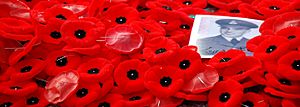
After the Remembrance Day ceremony, people often take off their poppies. They place them on or near the cenotaph (a monument to those who died in war).
Until 1996, disabled veterans in Canada made the poppies. Now, a private company makes them. Canadian poppies are made of two plastic pieces with a soft, fuzzy surface. They have a pin to attach them to clothes. The poppies first had a black center. From 1980 to 2002, the centers were green. Now, they are black again. In 2007, poppy stickers were made for children and others.
Canada also has a metal "Canada Remembers" pin. It has a gold maple leaf and two poppies. One poppy is for those who died. The other is for those who stayed home and helped during the war.
Since 2000, a new tradition has started in Canada. After the national Remembrance Service, people place their poppies on the Canadian Tomb of the Unknown Soldier. This tomb is at the National War Memorial in Ottawa. Many people across the country now do this. They also leave flowers, photos, or letters.
Poppies in New Zealand
In New Zealand, Remembrance Poppies are most often worn on Anzac Day (April 25). They remember New Zealand soldiers who died in war. They are also worn on Remembrance Day. The Royal New Zealand Returned and Services' Association (RSA) sells them to raise money. The RSA planned their first Poppy Day in 1921. But the ship carrying the poppies from France arrived too late. So, they waited until Anzac Day 1922. This first Poppy Day was very successful. Most of the money helped soldiers and their families. Some money went to help children in war-torn France.
Poppy Day became very popular. Many poppies were given out during World War II. By 1945, 750,000 poppies were given out. This was half of the country's population.
Poppies in the United Kingdom
In the United Kingdom, The Royal British Legion (RBL) sells Remembrance Poppies. The RBL is a charity that helps people who have served in the British Armed Forces. Volunteers sell poppies on the streets in the weeks before Remembrance Day. The Remembrance Poppy is a special symbol owned by The Royal British Legion. They say the poppy is used only to raise money for their "Poppy Appeal." This is their yearly fundraising drive. The RBL says poppies are "worn to commemorate the sacrifices of our Armed Forces and to show support to those still serving today." Other poppy items are sold all year to raise money.
In England, Wales, and Northern Ireland, poppies usually have two red paper petals. They are on a green plastic stem with a green paper leaf. They have a black plastic center. The stem has a pin to attach the poppy to clothes. In Scotland, poppies are curled and have four petals with no leaf. Selling poppies each year brings in a lot of money for the RBL. The poppy does not have a set price. People give a donation, or the seller might suggest a price. The black center of the poppy used to say "Haig Fund" until 1994. Now it says "Poppy Appeal."
About 50 people, mostly disabled former British military members, make millions of poppies each year. They work at the Poppy Factory in Richmond. Scottish poppies are made at the Lady Haig's Poppy Factory in Edinburgh.
For many years after World War I, poppies were only worn on Remembrance Day. Today, the RBL's "Poppy Appeal" is very well known. Poppies are seen everywhere from late October to mid-November. They are worn by regular people, politicians, the Royal Family, and other public figures. You can see large poppies on buses, trains, and airplanes. They are also on lampposts, billboards, and buildings. Many newspapers and magazines show a poppy on their cover. Some people add poppies to their online pictures. Each year, a special song is released for the Poppy Appeal. Poppy sellers are found on streets and at many public events. In 2014, a huge art display called Blood Swept Lands and Seas of Red was made at the Tower of London. It had 888,246 ceramic poppies. Each one stood for a British Empire soldier killed in World War I.
In 1997 and 2000, The Royal British Legion officially registered the poppy as their special symbol.
Poppies in Northern Ireland
The Royal British Legion also has a yearly poppy appeal in Northern Ireland. In 2009, they raised over £1 million. Wearing poppies in Northern Ireland can be a sensitive topic. Some people see it as a political symbol. It can represent support for the British Army. The poppy has often been worn by the unionist and loyalist communities. These groups support Northern Ireland remaining part of the United Kingdom. Some loyalist groups have also used poppies to remember their own members who died.
Most Irish nationalists and republicans choose not to wear poppies. They see the Poppy Appeal as supporting soldiers who were involved in actions they disagree with.
Poppies in the Republic of Ireland
During World War I, all of Ireland was part of the United Kingdom. About 200,000 Irishmen fought in the British Army. During World War II, about 70,000 people from the independent state of Ireland served in the British armed forces. A list at Trinity College Dublin shows 3,617 people from the Republic who died in that war. The RBL has a branch in the Republic of Ireland. They hold a ceremony at St Patrick's Cathedral, Dublin. The President of Ireland has attended this event.
The Republic of Ireland has its own National Day of Commemoration in July. This day remembers all Irish people who died in war. Poppies are not often worn in Ireland. This is partly because of the British Army's role in fighting against Irish independence. It is also because of its role in Northern Ireland during the Troubles.
In the years after the Irish War of Independence, the poppy was very controversial. Irish nationalists saw it as a symbol of British rule. In Dublin, people sometimes pulled poppies off others' clothes. This led to fights. Over time, wearing the poppy became less common in Dublin.
In 2017, Taoiseach (Prime Minister) Leo Varadkar wore a "shamrock poppy" in the Dáil (Irish Parliament). He was the first Taoiseach to do so.
Poppies in the United States
In the United States, the Veterans of Foreign Wars first gave out remembrance poppies across the country in 1922. This was before Memorial Day. Today, the American Legion Auxiliary gives out paper poppies. They ask for donations around Memorial Day and Veterans Day.
Poppies in Hong Kong
In Hong Kong, which used to be a British colony, some people wear the poppy on Remembrance Sunday. Most of the public does not wear it. However, The Royal British Legion's Hong Kong and China Branch sells poppies in a few places.
Poppies in Ukraine
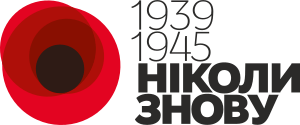
Since 2014, Ukrainians have worn the poppy. It is a symbol of the Victory over Nazism and to remember those who died in World War II. It has largely replaced another symbol. A poppy logo was designed by Serhiy Mishakin. It says: "1939-1945 Never Again."
Poppies in Pakistan
In parts of Pakistan, a group called the 'Great War Company' holds a private ceremony on November 11. People wear red poppies there. These people are descendants of World War I veterans from the old British Indian Army.
Poppies in Albania
In Albania, government leaders, including Prime Minister Edi Rama, wore the Remembrance Poppy. This was during ceremonies for the 70th Anniversary of the Liberation of Albania.
Other Poppy Designs
White Poppies

Some people choose to wear white poppies. These are an alternative to the red poppy. White poppies were first introduced in Britain in 1933 by the Co-operative Women's Guild. Today, the Peace Pledge Union sells white poppies. People can also make them at home. A white poppy can be worn alone or with a red poppy. The Peace Pledge Union says it remembers all people who died in war. This includes civilians and non-British people. It also stands for peace and does not make war seem glamorous. In the 1930s, some women lost their jobs for wearing white poppies. Today, some people still criticize white poppies. They feel white poppies take away from the meaning and fundraising of the red poppy.
Purple Poppies
To remember animals who died in war, Animal Aid in Britain created a purple remembrance poppy. It can be worn with the red poppy. It reminds people that both humans and animals have been victims of war. Recently, the purple poppy was changed to a purple paw symbol. This can be worn all year. This change happened because some people felt the poppy suggested animals chose to give their lives. Animal Aid believes animals' lives are taken by humans in war.
Black Poppies
On Remembrance Sunday in 1999, a group in Merseyside protested against war. They placed a wreath of black poppies on a monument in Liverpool. In 2014, the black poppy became a symbol against war for the Stop the War Coalition. This group reported that "anti militarists" in Glasgow gave out 16,000 black poppies. These were in memory of people who refused to fight in World War I.
Khadi Poppies
The khadi poppy was introduced in 2018. It was created by Jitesh Gadhia and The Royal British Legion. It is meant to show thanks for the help of 1.5 million people from India. It also thanks people from other Commonwealth countries who helped in the First World War. These poppies look like the red Legion poppy. But their petals are made of khadi. Khadi is a special cotton cloth made popular by Mahatma Gandhi. Jitesh Gadhia said the khadi poppy is a very important way to recognize the big help from Indian soldiers. He also said it helps connect with people whose ancestors fought in the war. He believes British Asians should be proud of their ancestors' role in shaping the world.
British Prime Minister Theresa May has worn the khadi poppy. Cricketers Joe Root and Virat Kohli also wore it before a cricket match in September 2018.
See also
 In Spanish: Amapola del recuerdo para niños
In Spanish: Amapola del recuerdo para niños


